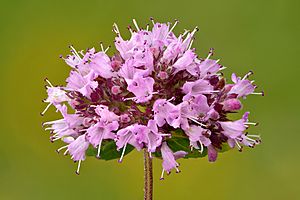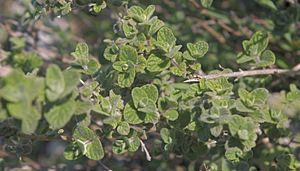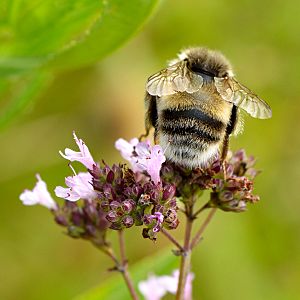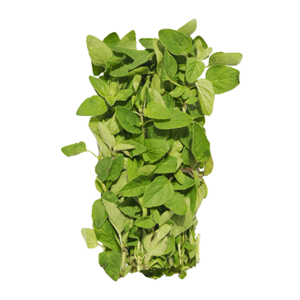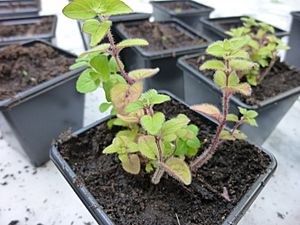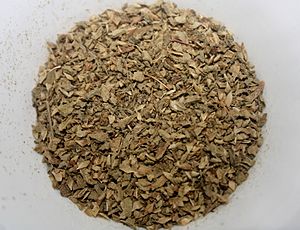Oregano facts for kids
Quick facts for kids Oregano |
|
|---|---|
 |
|
| Scientific classification | |
| Genus: |
Origanum
|
| Species: |
vulgare
|
Oregano (scientific name: Origanum vulgare) is a type of flowering plant. It belongs to the mint family. This plant first grew in the Mediterranean region. Now, you can find it all over the temperate parts of the Northern Hemisphere.
Oregano is a perennial plant, which means it lives for more than two years. It can grow from about 20 to 80 centimeters (8 to 31 inches) tall. Its leaves are opposite each other on the stem and are 1 to 4 centimeters (0.4 to 1.6 inches) long. In summer, oregano produces small flowers. These flowers can be white, pink, or light purple.
Sometimes, oregano is called wild marjoram. A plant very similar to it, O. majorana, is known as sweet marjoram. Both oregano and marjoram are popular herbs used in cooking. They are especially common in Turkish, Greek, Spanish, Italian, and French foods. Oregano is also grown as an ornamental plant because of its pretty leaves and flowers.
Contents
What's in a Name? The Meaning of Oregano
The word oregano comes from the Spanish language. It then came from the Latin word orīganum. The original word is from Classical Greek, orī́ganon.
This Greek word is made of two parts. Óros means "mountain" and gános means "brightness". So, oregano means "brightness of the mountain". This name might describe how the plant looks when it grows on hillsides.
About Oregano: Description and Growth
Oregano is closely related to the herb marjoram. Some people even call it wild marjoram. It has purple flowers and green leaves shaped like spades. Oregano is a perennial plant. This means it can live for many years. However, in very cold places, it might not survive the winter. In those areas, people often grow it as an annual plant.
You should plant oregano in early spring. Give each plant about 30 centimeters (12 inches) of space. It grows best in fairly dry soil and needs lots of sun. Oregano can grow in different types of soil. It likes soil that is slightly acidic to strongly alkaline. It prefers a hot and dry climate. But it can still grow well in other environments.
Different Types of Oregano
Over many centuries, people have grown different types of oregano. Each type has its own special flavors or other features. The taste can range from spicy or strong to sweet and complex. Simple oregano that you might find in a garden store may not have a very strong taste. Its leaves might be larger and less dense. This type is not always the best for cooking.
Other plants are also related to oregano and have similar flavors. For example, Origanum onites from Greece and Turkey. Also, O. syriacum from West Asia tastes similar. Marjoram from Turkey is a close relative. It tastes different because it doesn't have certain natural chemicals in its oil. Some types of oregano have a taste that is somewhere between oregano and marjoram.
Main Kinds of Oregano
Here are some accepted types of oregano:
- O. v. subsp. glandulosum: Found in Tunisia and Algeria.
- O. v. subsp. gracile: This type has shiny green leaves and pink flowers. It grows well in pots. Its flavor is strong and spicy. You can find it in Central Asia, Iran, India, Turkey, Afghanistan, and Pakistan.
- O. v. subsp. hirtum: Also called Italian or Greek oregano. This is a common type used in cooking. It grows strongly and is very tough. It has darker green, slightly hairy leaves. Many people think this is the best type for all-around cooking. It grows in Greece, the Balkans, Turkey, and Cyprus.
- O. v. subsp. virens: Found in Morocco, Spain, Portugal, and some islands like the Balearic Islands and Madeira.
- O. v. subsp. viridulum: This type is found in many places, from Corsica to Nepal.
- O. v. subsp. vulgare: This is the most common type. It grows across Europe and Asia, from Ireland to China. It has also started growing naturally in North America and Venezuela.
Popular Oregano Varieties
Here are some popular varieties of oregano that people grow:
- Aureum: This variety has golden leaves. They become greener if grown in the shade. It has a mild taste. This type has won an Award of Garden Merit.
- Greek Kaliteri: This is a type of O. v. subsp. hirtum. It has small, dark, thick, and slightly hairy leaves. These leaves often have purple undersides. It is known for its excellent flavor and strong taste. It also has traditional medicinal uses. The Greek word kaliteri means "the best."
- Hot & Spicy: Another type of O. v. subsp. hirtum.
- Nana: This is a dwarf variety, meaning it stays small.
Some types sold as Italian or Sicilian oregano are actually a hybrid plant. They are a mix between O. v. subsp. hirtum and sweet marjoram (O. majorana). These types are known for their sweet and spicy flavors. They have little bitterness and are great for many recipes.
How People Use Oregano
Cooking with Oregano
Oregano is a popular herb used in cooking. Its leaves give food a special flavor. The flavor can be even stronger when the leaves are dried. Oregano has an earthy, warm, and slightly bitter taste. The strength of the flavor can change. Good quality oregano can be so strong it almost makes your tongue tingle. But types grown in colder places might have a milder taste.
Many things can affect oregano's flavor. These include the climate, the season, and the type of soil. Some of the chemicals that give oregano its flavor are carvacrol, thymol, and limonene.
Oregano is a key herb in Italian cuisine. It is often used with roasted, fried, or grilled vegetables, meat, and fish. It goes very well with spicy foods, which are popular in southern Italy. In northern Italy, marjoram is often preferred instead of oregano. Oregano became popular in the U.S. after World War II. Soldiers who returned from Italy had developed a liking for this "pizza herb."
Oregano is also widely used in foods from the Mediterranean Basin and Latin America. It is especially common in Mexican cuisine and Argentine cuisine. In Turkish cooking, oregano is mostly used to flavor meat, especially lamb. In barbecue and kebab restaurants, you can often find it as a condiment. It is usually served with paprika, salt, and pepper.
In Portugal, people often add a lot of dried oregano to tomato and cucumber salads in the summer. It is also used to season meat and fish dishes. In Greece, dried and ground oregano leaves are often added to Greek salad. It is also usually put in the lemon-olive oil sauce that goes with grilled fish or meat. In Albania, dried oregano is often used to make herbal tea. This tea is very popular in northern Albania.
Oregano Oil
People have used oregano oil in folk medicine for hundreds of years. Oregano essential oil is taken from the leaves of the oregano plant. Even though oregano or its oil might be used as a dietary supplement, there is no scientific proof that it helps human health.
Other Plants Called "Oregano"
Sometimes, other plants are also called "oregano." But they are not the same as true oregano.
- Coleus amboinicus: This plant is known as Cuban oregano, French oregano, or Mexican mint. It is also in the mint family. It has large, somewhat succulent leaves. This plant is common in tropical areas around the world.
- Lippia graveolens: This plant is called Mexican oregano. It is not in the mint family, but in the related vervain family. Mexican oregano has a stronger savory taste. It also has a citrus hint, which makes it more aromatic than true oregano. It is becoming more common outside of Mexico.
- Hedeoma patens: This plant is known as "small oregano" in Spanish. It is also in the mint family. People use it as an herb in some Mexican states.
See also
 In Spanish: Orégano para niños
In Spanish: Orégano para niños
- Thymus vulgaris, thyme


